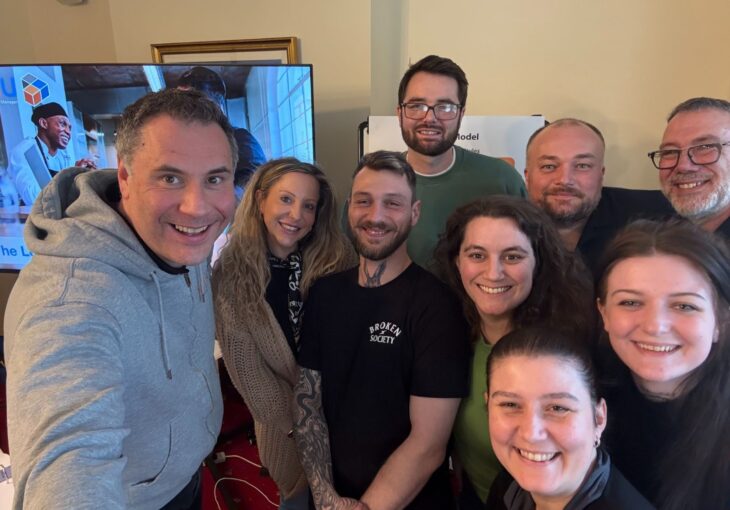
Earlier this year, I took a trip to sunny Florida to take part in The New Leader of Managers programme. It was, essentially, an expert-driven masterclass in multi-unit management and was co-hosted by long-term MMU associate, Professor Christopher Muller. Described as “the world authority on the restaurant industry”, Chris’s pioneering work informs our approach to leadership programmes.
After three years of dealing with the lingering impact of COVID on the global restaurant industry, accompanied by ten years of technological advancement, Chris has updated his book, The Leader of Managers for 2023. The book has updated materials from decades of experience teaching and writing about restaurant chains. We wanted to share an excerpt from his book with you:
“The Pandemic broke almost all the rules of traditional restaurant management. In the early stages, as restaurants were forced to close their doors, and employees were sent home, many took stock of themselves as they sought to find economic and emotional support. The restaurant industry, typically associated with low-paying, low-status, and in many cases low-commitment jobs, was suddenly faced with a workforce not completely sure they wanted to return to an ancient system that offered high job insecurity coupled with limited benefits.
Coincidentally there is a demographic reality that creates a shortage of traditional entry-level restaurant workers aged 16 to 25. Basically, we all stopped “making 16-year-olds 16 years ago” so there are fewer to hire and train.
It is a foundational belief that finding, motivating, and retaining qualified labor must be the primary concern of the Leader of Managers. We have repeatedly highlighted this process, especially for the Assistant Unit Manager position, the primary source of all company growth and area stability. But the typical pathway to management, progressing from hourly employee to supervisor to assistant manager has been disrupted, if not completely broken.
The new leader of managers should not personally responsible for unit level staffing and scheduling, that is the role of the restaurant unit general manager. Unfortunately, restaurant units that are understaffed are typically also those that underperform. Ultimately that is the responsibility of the new leader of managers.
Of course, restaurant companies and their employees weren’t the only places that faced the enigma asking what the “meaning of work” would be in the post-Pandemic era. Full employment, across much of the developed world, was a reality going into 2020. Restaurants had been dealing with a labor shortage for several years, as high consumer demand meant more restaurant openings, which required more kitchen and service workers.
Today, the labor shortage isn’t so much from new openings, but from people who have left the industry all together. Real wages have never been higher, in many parts of the United States as of January 1, 2023, minimum wage has passed $15.00 per hour, with de facto minimums running 20-30% higher than that. Yet, according to the National Restaurant Association, at the end of 2022 more than 75% of restaurants reported they were not fully staffed. Given the reality of demographic trends and the changing attitudes of the core employment base, there is little reason to believe they will return to full staff levels anytime soon.
What changes will this bring for the new leader of managers? Restaurants are in the “service economy” and service implies human to human interaction. I have often suggested that everything in our world happens “within one square meter” the physical place where customer and service provider meet. In quick service, fine dining, and everything in between, from a funky food truck to a three-star Michelin cathedral of food, there has always been a human being providing an intimate connection to another human being. As highlighted in the 1st Edition, human resource management was about leadership, team building, delegation and persuasion. These are the skills of a leader of managers.”
This is some of the thinking that Chris shared when I was over in Florida. What strikes me is, even with the technological advancements of the past decade, the challenge remains at a human, personal level. How do you excite, engage, and grow your people, so that they are equipped and motivated to deliver exceptional (and consistent) customer experiences?
It therefore remains the fundamental role of the leader of managers to develop the capabilities of their teams. This is simply too important to be left to chance. True growth and performance improvements must be made through intentional planning and a disciplined and relentless focus to bring those plans to fruition.
Whatever the challenges, the future is bright for the food service industry; as Chris says, “The new leader of managers faces challenges, but what opportunities they bring”.
If you’d like to find out more about Chris’s thinking and hear more about how the role of the multi-unit leader has changed and how today’s leader of managers should adapt to the complexities and opportunities they face, Chris will be joining us for our next free webinar on April 25, 10:00 EST | 15:00 GMT | 16:00 CET.


